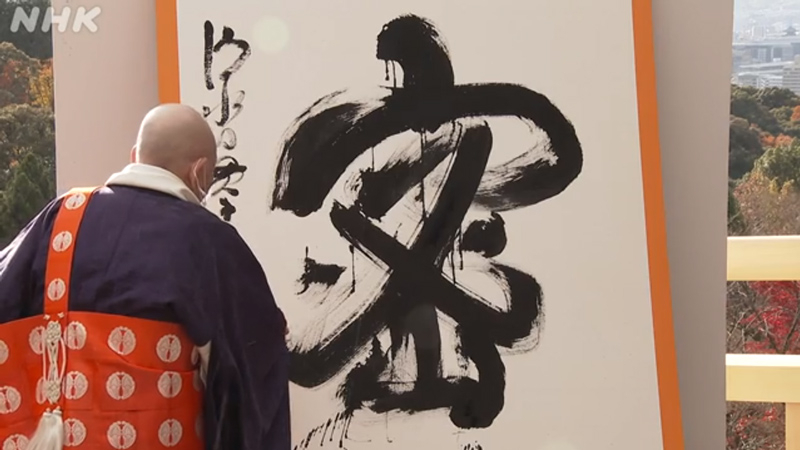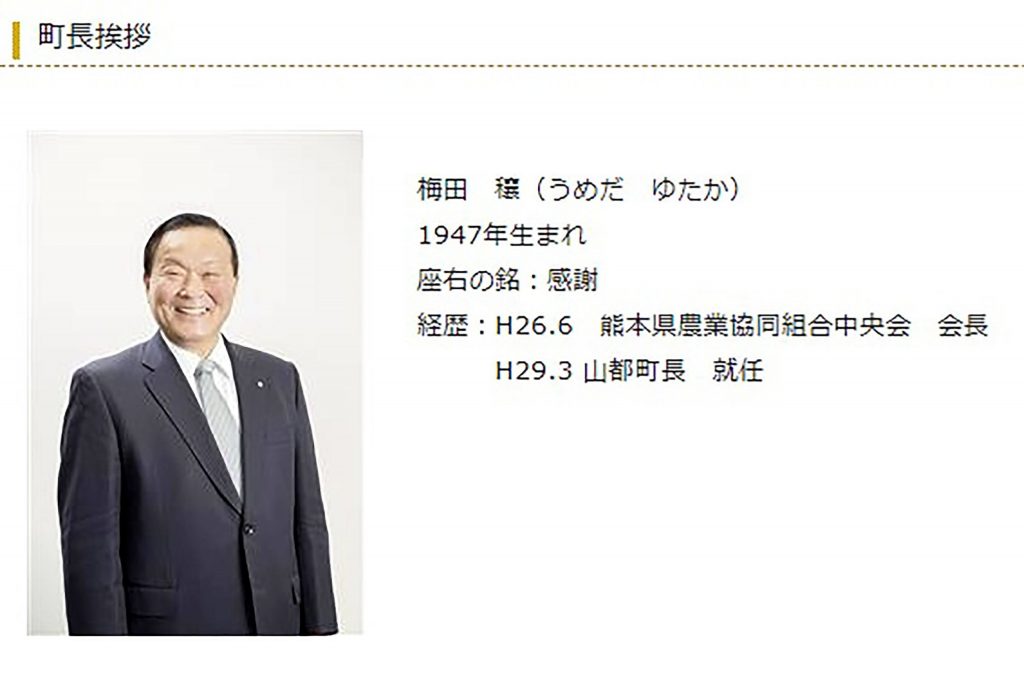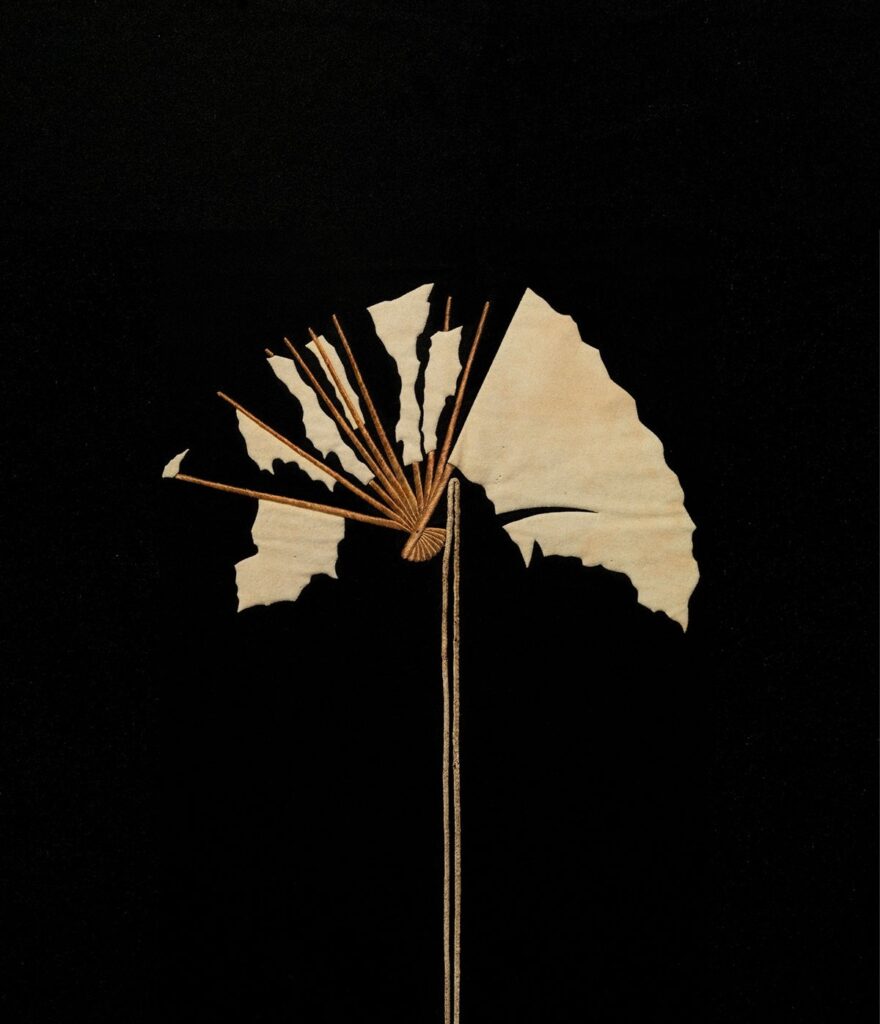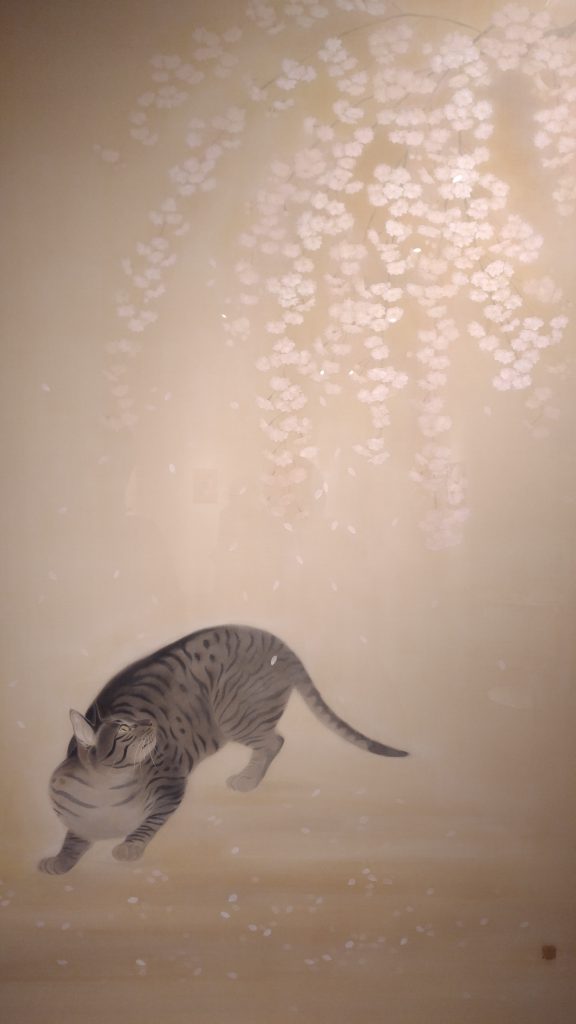WIT Life #349: 今年の漢字
Interpreter/Translator/Writer Stacy Smith (Kumamoto-ken CIR, 2000-03) presents WIT Life, a periodic series about aspects of Japanese culture such as art, film, food and language. Stacy starts her day by watching Fujisankei’s newscast in Japanese, and here she offers some interesting tidbits and trends along with her own observations.

We have come to the end of this crazy Covid year, and that means it’s time for 今年の漢字 (kotoshi no kanji, or kanji of the year). 密 (mitsu, or close, dense and crowded) was selected, reflecting Japan’s initial response to the virus by promoting avoidance of 三つの密 (mitsu no mitsu or sanmitsu). These are also known as the 3Cs, and refer to 密閉 (mippei, or confined, poorly ventilated spaces), 密集 (misshuu, or crowds of people) and 密接 (missetsu, or close-contact settings). Japan was able to control infection rates to an extent this way, but as in the U.S. there are worries of a surge early next year as a result of gathering during the 年末年始 (nenmatsu nenshi, or year-end holidays). Runners-up to 密 included 禍 (ka, or damage, as in コロナ禍) and 病 (byou or yamai, or disease and illness).
Read MoreWIT Life #348: Japan’s Joe Biden?
Interpreter/Translator/Writer Stacy Smith (Kumamoto-ken CIR, 2000-03) presents WIT Life, a periodic series about aspects of Japanese culture such as art, film, food and language. Stacy starts her day by watching Fujisankei’s newscast in Japanese, and here she offers some interesting tidbits and trends along with her own observations.
Since I last wrote, Joe Biden has been officially declared the winner in the election. My former home prefecture in Japan has a surprising connection to our next President. Yutaka Umeda is the mayor of a 15,000 person small town in Kumamoto called Yamato. The kanji for his name (梅田穣) can also be read as Jo Baiden, allowing him to capitalize on this coincidence. It remains to be seen if he will have as much success as the city of Obama (小浜市) in Fukui Prefecture, which gained much attention when the former president with this name took office.

WIT Life #347: Japan events
Interpreter/Translator/Writer Stacy Smith (Kumamoto-ken CIR, 2000-03) presents WIT Life, a periodic series about aspects of Japanese culture such as art, film, food and language. Stacy starts her day by watching Fujisankei’s newscast in Japanese, and here she offers some interesting tidbits and trends along with her own observations.
As we get deeper into fall, I hope everyone has been enjoying the cooler temps, かぼちゃ (kabocha or pumpkin), and 紅葉 (kouyou or autumn foliage). I went hiking upstate two weeks ago and the leaves were just starting to turn pretty colors, so I’m hoping when I go again this weekend they will be in their full glory.

In sad news, last Sunday’s Times featured a story on the horrific attack on Japanese pianist Tadataka Unno. I first heard about what happened on the Japanese news, and since then many publications have covered it. A groundswell of support followed this tragedy, and a GoFundMe campaign to help Unno and his family has since raised more than $255,000.
Finally, there are couple of great webinars coming up for all you Japanophiles. Tonight at 8 pm Columbia’s Center on Japanese Business and Economy will discuss the transition from Abenomics to Suganomics. Tomorrow at 6 pm Japan Foundation will sponsor a Q&A with Stephen Snyder, known for translating The Memory Police by Yoko Ogawa (excellent read!), nominated for this year’s International Booker Prize. For all the Noh fans out there, Noh Society will be continuing its monthly webinar series this Saturday at 8 pm with a session focusing on the play Izutsu, based on the classic literary work The Tales of Ise. In addition, the 21st Century Japan Politics and Society Initiative at Indiana University has a bunch of interesting events coming up. You can directly sign up for next month’s webinar, but for next year’s events you have to sign up to the mailing list to receive further information. Happy viewing!
Read MoreWIT Life #346: 「OO活」・「OOハラ」
Interpreter/Translator/Writer Stacy Smith (Kumamoto-ken CIR, 2000-03) presents WIT Life, a periodic series about aspects of Japanese culture such as film, food and language. Stacy starts her day by watching Fujisankei’s newscast in Japanese, and here she offers some interesting tidbits and trends along with her own observations.
Since I last wrote, Japan has ushered in new Prime Minister Yoshihide Suga. He served as Chief Cabinet Secretary under PM Abe for a decade (and also served as Minister of Internal Affairs and Communications for a year in his previous administration ). Best of luck to the first new PM of the Reiwa Era!

WIT Life #345: 涙活
Interpreter/Translator/Writer Stacy Smith (Kumamoto-ken CIR, 2000-03) presents WIT Life, a periodic series about aspects of Japanese culture such as film, food and language. Stacy starts her day by watching Fujisankei’s newscast in Japanese, and here she offers some interesting tidbits and trends along with her own observations.
In recent days the Japanese news has been buzzing with news of PM Abe’s frequent hospital visits, and he officially resigned his post during today’s press conference. In the midst of the coronavirus crisis, Abe determined that stepping down due to a flareup of ulcerative collitis was the prudent choice. Intense speculation is taking place as to who within the LDP will be named as his successor, to serve out the remainder of his term through next September. Abe holds the record as Japan’s longest serving PM.

If this news brings you to tears consider crying therapy (涙活 or ruikatsu), which I’ve previously introduced in this column. There are a slew of Japanese words that have been coined with the kanji for “activity” as a suffix (活 or katsu). Some examples are trying to get pregnant (妊活 or ninkatsu), job searching (就活 or shuukatsu), and planning for one’s death (終活 or shuukatsu. Incidentally, this has the same pronunciation as the previous one so be careful!). Ruikatsu is the subject of the NYT featured op-doc Tears Teacher. Clocking in at less than 11 minutes, this short film is definitely worth a watch. Enjoy and stay safe out there!
WIT Life #344: BLM in Japan
Interpreter/Translator/Writer Stacy Smith (Kumamoto-ken CIR, 2000-03) presents WIT Life, a periodic series about aspects of Japanese culture such as film, food and language. Stacy starts her day by watching Fujisankei’s newscast in Japanese, and here she offers some interesting tidbits and trends along with her own observations.
As we entered July the wave of protests for Black Lives Matters seemed to have subsided a bit, but the fighting spirit is strong. It has even made its way to Japan, as this NYT article highlights. However, as it indicates, recognition of racism in Japan is still woefully inadequate and its existence is often denied.
Although Japan had some protests post-Fukushima, there is clearly still resistance to these types of movements as they have never been part of Japanese culture. It remains to be seen as to whether this changes in the future, along with the country’s increased diversification.
And in local news, I was featured in a July 4th interview so please check it out here!
WIT Life #343: Dispatches from Japan (courtesy of NYT)
Interpreter/Translator/Writer Stacy Smith (Kumamoto-ken CIR, 2000-03) presents WIT Life, a periodic series about aspects of Japanese culture such as film, food and language. Stacy starts her day by watching Fujisankei’s newscast in Japanese, and here she offers some interesting tidbits and trends along with her own observations..
We entered Phase 2 this week and it looks like New York continues to move in the right direction, though the same cannot be said for other parts of the country. Tokyo has also seen a slight rise in cases, but the alert was recently lifted so perhaps that has something to do with it.
I’ve been watching the Japanese news and reading the New York Times to keep tabs on how the virus is affecting Japan, and I’d like to share some articles I found most informative and/or interesting.
Last month there was a NYT article about how the pandemic has affected Japanese men and their domestic duties. This month’s reporting focused on the deeply ingrained culture of mask wearing in Japan, as well as how it has been able to maintain a low jobless rate despite the crisis. Happy reading!
WIT Life #342: Turning a corner on Covid
Interpreter/Translator/Writer Stacy Smith (Kumamoto-ken CIR, 2000-03) presents WIT Life, a periodic series about aspects of Japanese culture such as film, food and language. Stacy starts her day by watching Fujisankei’s newscast in Japanese, and here she offers some interesting tidbits and trends along with her own observations.
Hope everyone is doing well in quarantine and looking forward to early summer. It seems like we’re getting closer to having some restrictions lifted here in NY. Over in Japan, the number of cases remains low and PM Abe just lifted the state of emergency for Tokyo and the other four prefectures that were still under it. However, it seems like his time in office might be cut short due to several significant blunders.

It’s been a heartbreaking week in non-Corona related domestic news, and I’ve been using podcasts and webinars to keep my mind off the awfulness. I’m especially fond of Asia Society programming, and tonight at 6:30 you can check out “Tattered Fans and Talismans.” It’s streaming on the organization’s Facebook page, but if you aren’t able to catch it live they offer access to events post-recording.
And in other exciting news, mark your calendars for the inaugural Casa Con! This all digital convention focusing on gaming, content creation and cosplay will be held on Discord from June 12-14. If the fact that I’ll be participating in a panel discussion on Saturday the 13th at 5 p.m. is not enough motivation for you to attend, registration is free! You can connect with the event over social media at #casacon and @thecasacon.
WIT Life #341: Hanami at home
Interpreter/Translator/Writer Stacy Smith (Kumamoto-ken CIR, 2000-03) presents WIT Life, a periodic series about aspects of Japanese culture such as film, food and language. Stacy starts her day by watching Fujisankei’s newscast in Japanese, and here she offers some interesting tidbits and trends along with her own observations.
Hope everyone is holding up ok as we enter our second month of sheltering at home. Some days are better than others, but one thing I’m really missing is soaking up spring. This would typically be the season when I’d be attending all of the 桜祭り (sakura matsuri or cherry blossom festivals) in various parts of Queens, but of course that can’t happen this year.

Thankfully the Sato Sakura Gallery has a virtual fix for people who are craving the cherry blossoms. Check out this related article, which discusses 花見 (hanami or flower viewing) culture, as well as the museum’s amazing collection of sakura screens and paintings. For those who want a literal taste of sakura, try the cherry blossom shake at Shake Shack or pick up some sakura mochi at your local Japanese supermarket.

Hope this tides you over until next year, when we can hopefully enjoy the blossoms by sitting under them with food, drink and friends!
WIT Life #340: Coronavirus in Japan
Interpreter/Translator/Writer Stacy Smith (Kumamoto-ken CIR, 2000-03) presents WIT Life, a periodic series about aspects of Japanese culture such as film, food and language. Stacy starts her day by watching Fujisankei’s newscast in Japanese, and here she offers some interesting tidbits and trends along with her own observations.
Hello from day #? of coronavirus quarantine. Hope everyone is staying safe by hunkering down and practicing self-care. The news of legendary Japanese comedian Ken Shimura’s death from coronavirus was a shock to the entire nation. Some say this is what might be needed to awaken the populace to the potential danger that this pandemic brings.

So far infection rates in Japan have been very low. One reason may be a lack of testing, which many think was due to an attempt to salvage the Olympics. Other theories cite cultural aspects such as the propensity for problem denial, bowing instead of handshaking, and little display of PDAs. Other contributing factors are surely the popularity of masks, diligent hand washing, taking shoes off at home, and the ability to receive proper medical care because everyone is insured.
Up until now, the Japanese government’s limited strategy has been to focus on known cluster areas. The current guidelines for social distancing are avoiding 三つの密 (mitsu no mitsu, or three types of situations beginning with the kanji mi, meaning close). These are 密閉 (mippei, or poorly ventilated spaces), 密集 (misshuu, or crowds of people) and 密接 (missetsu, or close physical contact).
Read MoreInterpreter/Translator/Writer Stacy Smith (Kumamoto-ken CIR, 2000-03) presents WIT Life, a periodic series about aspects of Japanese culture such as film, food and language. Stacy starts her day by watching Fujisankei’s newscast in Japanese, and here she offers some interesting tidbits and trends along with her own observations.
Recently I had the chance to check out the newest exhibition at the Sato Sakura Gallery, Curious Beasts. As the name indicates, this collection of paintings is of animal portraits ranging from cats and tigers to dogs and birds. The works are from the artists Fumika Koda and Yuji Musashihara, and being a cat lover I was partial to Koda’s paintings as they mostly feature felines. In particular, I liked her painting Beautiful Spring Day (春うらら, haru urara), which shows a cat caught under falling cherry blossoms (花吹雪, hanafubuki).

WIT Life #337: Japanese Home Cooking
Interpreter/Translator/Writer Stacy Smith (Kumamoto-ken CIR, 2000-03) presents WIT Life, a periodic series about aspects of Japanese culture such as film, food and language. Stacy starts her day by watching Fujisankei’s newscast in Japanese, and here she offers some interesting tidbits and trends along with her own observations.
It’s been a long time since I’ve written here, and I can’t believe the holiday season is already upon us! If you are like me and are still in the midst of Christmas gift shopping, what better present is there than books? In the last week I’ve visited various bookstores in the city, and was lucky enough to be introduced to the fantastic new cookbook Japanese Home Cooking (Simple Meals, Authentic Flavors) from the cooking teacher, noodle maker, grain activist and author Sonoko Sakai.

California-based, Queens-born Sakai shares personal stories while showcasing traditional Japanese dishes in this beautifully photographed book. She offers readers advice on how to stock their pantries with the necessary ingredients for creating any Japanese meal, as she views this as the most important aspect of Japanese cuisine (she often takes students on tours of Japanese grocery stores as they can be hard to navigate if you are not familiar with what is being sold). I like how she opens the book by describing freshness, beauty, seasonality, simplicity and economy as the five keys to Japanese cooking. As an introduction she also breaks down the five elements of cooking and eating (i.e. five colors, five senses, five flavors), making these essential aspects easy to remember.
WIT Life #336: June Japanese movie round-up
Interpreter/Translator/Writer Stacy Smith (Kumamoto-ken CIR, 2000-03) presents WIT Life, a periodic series about aspects of Japanese culture such as film, food and language. Stacy starts her day by watching Fujisankei’s newscast in Japanese, and here she offers some interesting tidbits and trends along with her own observations.
The weather is getting warmer by the day, and soon we’ll be seeking air-conditioned movie theaters to escape the heat. Here are some Japan-related films in June that you might want to check out to stay cool and entertained! 
Earlier this month I enjoyed Metrograph’s Ryusuke Hamaguchi series. I was able to finally catch Asako I & II (寝ても覚めても), after having the chance to interpret for Hamaguchi several years ago when his epic Happy Hour (ハッピーアワー) came to MoMA. This month the theater will feature Kon Ichikawa’s Alone Across the Pacific, based on the eponymous non-fiction book about the first successful transpacific solo sea voyage from Nishinomiya, Japan to San Francisco, California.
If short films are more your thing, don’t miss Asia Society’s New York Japan CineFest next week. This two-night program features a diverse lineup of shorts, as well as Read More
WIT Life #335: End of an era
Written by professional Writer/Interpreter/Translator Stacy Smith (Kumamoto-ken CIR, 2000-03), WIT Life is a periodic series about aspects of Japanese culture such as film, food and language. Stacy starts her day by watching Fujisankei’s newscast in Japanese, and here she shares some interesting tidbits and trends along with her own observations.
In Japan today was the last day of its 30-year Heisei (平成) Era, and tomorrow is the official start of the new Reiwa (令和) Era. This is Japan’s 248th era with an official name, a number higher than America’s 243 years of history! You might have heard how the new name has been slightly controversial and largely underwhelming in terms of people’s reaction to it. In celebration of the new imperial era, this year’s Golden Week is an extra-long 10 days. Japan is a famously vacation-averse country, and true to form some citizens have been lamenting the length of the holiday. Other concerns in regard to the transition, such as updating stamps bearing the era name used for official documents and making sure computer systems are in compliance, are highlighted in this NYT article.
As the article details, there was plenty of time for preparation since Emperor Akihito’s abdication was announced in 2017. This is in contrast to the previous transition, which took place within Read More
WIT Life #334: Hikikomori shifting demographics
Written by professional Writer/Interpreter/Translator Stacy Smith (Kumamoto-ken CIR, 2000-03), WIT Life is a periodic series about aspects of Japanese culture such as film, food and language. Stacy starts her day by watching Fujisankei’s newscast in Japanese, and here she shares some interesting tidbits and trends along with her own observations.
The plight of Japan’s hikikomori (ひきこもり or voluntary shut-ins), has always been a topic that received a lot of buzz, but has primarily focused on young people affected by this phenomenon. However, according to a recent nationwide survey carried out by the Cabinet Office that was the first of its kind, recent trends indicate that it is actually older people who now comprise a larger percentage of Japan’s hikikomori population (gender-wise, men still comprise the majority of ![]()
![]() hikikikomori at a rate of around 3:1).
hikikikomori at a rate of around 3:1).
This BBC article characterized hikikomori as “modern-day hermits,” and describes how this condition is not only limited to Japan, but also seen in other Asian and European countries. In fact, the problem of loneliness and social isolation got so bad in the UK that it appointed its first designated minister for loneliness last year. Here in the States, loneliness has various deleterious effects, which have become Read More


